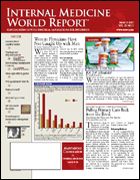Indian Herb May Help Combat Diabetes
Indian Herb May Help Combat Diabetes
By John Schieszer
SEATTLE—An herb used in traditional Indian medicine to treat diabetes appears to effectively lower serum sugar and plasma insulin levels. Over the next 3 months (ie, April to June 2005) researchers at Ohio State University will testSalacia oblonga extract in people with diabetes to see if it improves blood glucose control the way prescription oral medications do.
“Poor compliance with diabetes medications often hinders the effectiveness of these drugs,” said Steve Hertzler, PhD, assistant professor of nutrition at Ohio State University. “If we can start developing food products that contain an herb like this, then it may be an alternative to taking a pill.”
A recent study by Dr Hertzler and colleagues (J Am Diet Assoc. 2005;105:65-71) monitored the effects of S oblonga, an herbal alpha-glucosidase inhibitor native to regions of India and Sri Lanka,in 39 healthy adults. Test volunteers participated in 4 separate meal tolerance tests, which were given in beverage form and spaced 3 to 14 days apart. After fasting for at least 10 hours, participants were asked to drink 2 cups of the chilled beverage, which contained 0, 500, 700, or 1000 mg of S oblonga extract.
The study showed that the 1000-mg extract dose decreased blood glucose levels by 23% and insulin levels by 29% when compared with the control drink, which contained no herbal extract. The lower doses, however, had no impact on glucose or insulin levels. S oblonga binds to intestinal enzymes (alpha-glucosidases) that break down carbohydrates in the body. According to Dr Hertzler, if alpha-glucosidases bind to S oblonga rather than to a carbohydrate, less glucose gets into the bloodstream. “It is encouraging, and I am excited,” he recently told IMWR. “There are probably thousands of herbs like this.”
Because S oblonga can cause intestinal gas, volunteers gave breath samples every hour for 8 hours after drinking the test beverage. The breath samples were then analyzed for hydrogen and methane content. The level of either substance in the breath corresponds to the level contained in the colon. Volunteers also rated the frequency and intensity of nausea, abdominal cramping, distention, and gas for 2 days after consuming the test meal.
Although the test beverages containing S oblonga caused an increase in breath hydrogen excretion, reports of gastrointestinal discomfort were minimal. The current trial will now consider both optimal dosage and the best time to take the herb extract. “We want to know how long it takes for the herb to bind to the enzymes that break down carbohydrates,” Dr Hertzler said. “The participants in this study took the herb with their meal, but taking it before eating might be even more effective.”
Although S oblonga is still relatively difficult to find in the United States, there are manufacturers that sell it on the Internet. Dr Hertzler is currently conducting studies on the herb extract with the Ross Products Division of Abbott Laboratories. He has no links to the company, however, beyond this affiliation.
